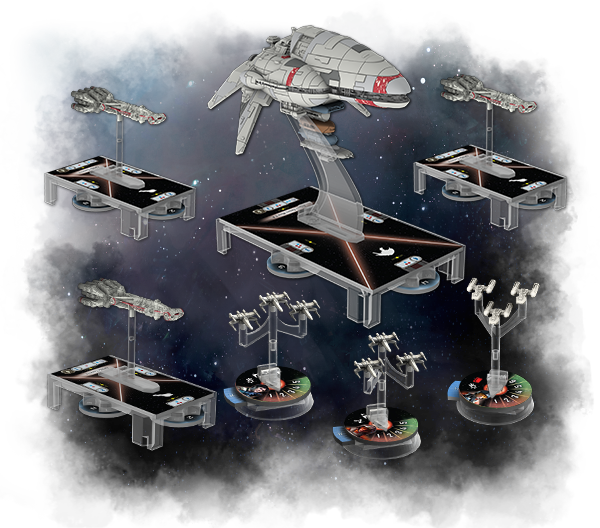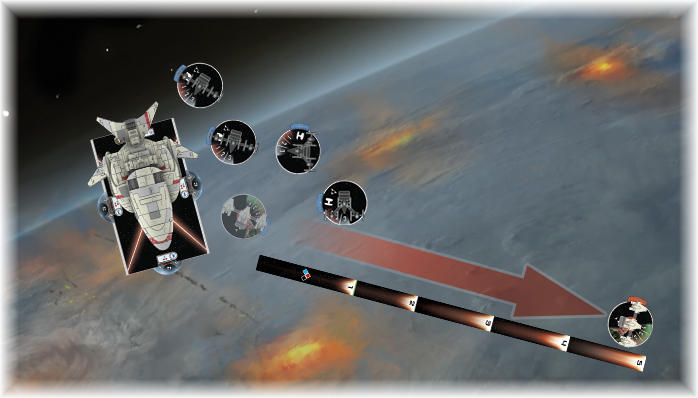Post by Fadril Adren on Mar 22, 2016 17:04:51 GMT -5


Developer Sam Stewart on the Many Paths to Victory
In Armada, capital starships and fighter squadrons wage heated space battles over six rounds. Each fleet's goal is to earn the most victory points by the end of the game. However, getting those victory points is more than just a matter of killing the enemy. Strategic choices mean that you may have plenty of opportunities to earn victory points, and those strategic choices come in the form of Objective cards.
The Power of Objectives
If you build your fleet and pick your Objective cards right, Armada is one game that you can win even as your opponent is decimating your fleet.
That may not be likely to happen, but as befits a game of fleet engagements, working toward your objectives is a major strategic part of the game. Objectives are designed so that they can completely change the tone and play style of a match, and smart admirals are always going to take them into account on their paths to victory.
There are two broad approaches towards managing objectives, and the primary difference is whether or not you want to bid for initiative. The choice to be first or second player goes to the player with the smallest fleet, and one of the first choices a player needs to make is whether to deliberately build a fleet with a reduced number of fleet points in order to win that choice, or to build a fleet as close to the full fleet point limit as possible.
Players who try to win the choice by building smaller fleets should generally plan on claiming initiative. The right to activate ships and squadrons first in every phase is extremely powerful, and it allows you to put your opponent on the back foot. Conversely, players who build a fleet as close to the point limit as possible should plan on forfeiting the initiative, and should build their lists accordingly. This is important, because players who plan on claiming initiative and being first player have to build their lists to accommodate their opponents' objectives, while players who anticipate playing as second player should build their lists to work with the objectives they choose.

Caught in range of the Star Destroyer's main guns, the Rebel CR-90 appears doomed…

…except for the fact that the Rebellion has the initiative. This means the Rebel player can choose to activate the CR-90 first, fire twice at the Star Destroyer's forward arc, and then race past the Star Destroyer at speed "4," ducking into the Star Destroyer's much less lethal rear arc.
Seizing the Initiative
When you decide to take the initiative as first player, you must then select one of the second player's three objectives to use during the game. This means you cannot guarantee that the game's objective will fit your fleet, so you need to build an "all comers" list that can accommodate a lot of different scenarios. It behooves you to build a fleet that is both more combat-oriented, and also more generalist.
Generalist fleets tend to incorporate a mix of both smaller, more maneuverable vessels, and larger ships that can take – and dish out – a serious pounding. These fleets also take a mix of squadrons that can fill multiple roles, intercepting dedicated bomber wings when necessary or turning their guns against enemy ships if your opponent didn’t bother to bring fighter cover of her own.
The first player's fleet also needs to be heavily combat-focused. As first player, you cannot guarantee that you’ll be able to pick an objective that plays to any of your fleet's strengths, so you must always be prepared to score your victory points by destroying enemy ships. This is where it’s good to have a powerful warship and a mix of squadrons with Bomber or squadrons like X-wings that are good at taking out enemy squadrons and still decent at damaging capital ships.

A balanced Imperial fleet designed to bid for initiative at 296 fleet points.
The Second Player
As second player, you sacrifice the initiative but force your opponent to play with one of the three objectives you bring to the table. This also means that you win the luxury of tailoring your fleet to fit your objectives. It's worth remembering, here, that going second doesn't just force your opponent to play with an objective that matches your fleet's composition, but all of the game's objectives are designed to help the second player in some way.
This means that as second player you can build your fleet with a more focused purpose. For example, if you're playing with a Rebel fleet, you may want to focus it around multiple CR-90 Corvettes and a few unique squadrons. This may seem risky, since the fleet won’t have heavy guns to kill off an opponent’s larger ships. But if you pick the right objectives, you won't have to kill off those ships. You can focus on scoring your victory points via your objectives, and you'll want to ensure your opponent faces three different “no-win” options at the beginning of the game.
For example, the fleet above could benefit from the objectives Dangerous Territory , Most Wanted , and Fire Lanes.

A 300-point Rebel fleet built to take advantage of its three objectives: Dangerous Territory, Most Wanted, and Fire Lanes.
Dangerous Territory places multiple objective tokens on the table, which can be more easily and more quickly claimed by multiple small ships. It also gives the second player the ability to ignore overlapping obstacles, which also benefits small ships and hampers an opponent.
Fire Lanes can also benefit multiple small ships, as the second player gets to set up the objective tokens in advantageous positions, where they can be easily accessed by small, fast ships.
Finally, Most Wanted is great for you as the second player and commander of a fleet of small ships because you can afford to have it spend the whole game fleeing engagements. Meanwhile, you can pick one of her opponent’s medium or large ships as the other objective ship, which will make all of your attacks against that ship much more powerful.
Kills or Objectives
Once you and your opponent sit down at the table, you want to decide whether you’re going to focus on scoring your victory points by meeting the objectives or by killing off enemy ships and squadrons.

Sometimes, the decision is easy. Not all objectives offer ways to gain additional victory points, and some of the objectives simply increase the fleet point values of objective ships, meaning you still have to kill your opponent's objective ship in order to score the additional points. In these cases, you’ll have to go for kills no matter what.
Many objectives, however, do offer ways to score victory tokens without eliminating enemy ships, and that’s where your choice becomes interesting. However, even as you decide how you want to go after your victory points, there are some things worth keeping in mind.
First, it’s almost never good to ignore victory tokens entirely. Only a few objectives, such as Intel Sweep , provide an “all or nothing” approach to scoring additional victory points; most objectives give out extra points based on the number of victory tokens each player accumulates throughout the battle. That means even if you plan on wiping out your enemy, you should make the effort to score a couple victory tokens. After all, your attacks may sometimes fail, but victory tokens are a sure thing once they’ve been scored.

Kills aren't everything. If you can score five objective tokens with Superior Positions, they're worth more victory points than a Victory I-class Star Destroyer !
Second, you need to be able to quickly and accurately size up the strengths of your ships versus your opponent's vessels. If the first player has a pair of Victory-class Star Destroyers and you have five CR-90 Corvettes as the second player, then you probably want to play for objective tokens instead of trying to go toe-to-toe with some very tough ships. Alternatively, if you brought an Assault Frigate Mk. II and some Y-wing bombers, destroying at least one of those Star Destroyers suddenly seems a lot more viable. It all comes down to how powerful – offensively and defensively – each side’s ships are, and figuring that out usually comes from experience.
Even if your fleet isn’t very good at scoring the objectives, you can still use the objectives to your advantage. As long as you know where your opponent needs to go to gain victory tokens, you can position your ships to intercept hers.
Know When To Pull Out
One of the more important lessons for any Armada fleet admiral is learning to quit while you’re ahead. Throughout the game, you'll want to keep in mind how many victory tokens you’ve scored, how many your opponent has scored, and roughly how many fleet points worth of ships and squadrons each side has killed.
Since Armada has a fixed turn limit and limited maneuverability, there may come a time when breaking off an engagement and flying away on late turns is your best strategy. If you find yourself ahead on points by round five, commanding a damaged ship or an expensive squadron like Tycho Celchu to cut and run from an engagement may keep it alive, and that keeps your opponent from scoring it for victory points.

The Rebel player commands a damaged Tycho Celchu to flee the battle, hoping to deny the Imperial player sixteen possible victory points.
But don't flee too early!
Not only do you give your opponent free reign of the board and the ability to score objectives, but the size of the battlefield and your ships' limited maneuverability make it difficult to hide forever. Tracking down a fleeing enemy is far from impossible, and fleeing early telegraphs your intentions, then gives your opponent plenty of time to intercept and destroy at least one or two ships.
Use Your Options
One of the things that keeps Armada interesting is the way that all of its elements work together. In the end, victory goes to the admiral who can manage all those elements best and make them work toward the larger, overall goal.

Set Your Course
There are many ways to approach your engagements in Armada, but the simplest and most obvious path to victory is always the elimination of all your opponent's ships and squadrons. However, such an aggressive and bloodthirsty approach to the game may not always be the best. The game's objectives ensure that your battles are strategic endeavors, not merely tactical slugfests. In the end, the victory doesn't always go to the player who destroyed the most ships and squadrons; it goes to the player who maintained focus on the larger goal and pursued them through maneuvering, battling, and the accumulation of objective tokens.


